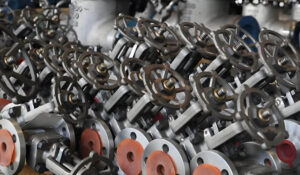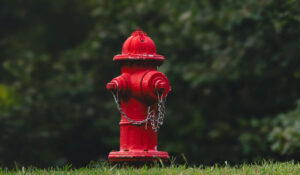عندما نتحدث عن السلامة من الحرائق، هناك القليل من الابتكارات التي تقف شامخة مثل رشاشات الحريق المتواضعة. في الواقع، لقد أنقذ هذا البطل المجهول عدداً لا يُحصى من الأرواح والمليارات من الأضرار التي لحقت بالممتلكات. تتمحور الثورة الخضراء في مجال السلامة من الحرائق حول جعل هذه الأنظمة أكثر كفاءة واستدامة واعتماداً على نطاق واسع. A رشاشات الحريق لم تعد مجرد فوهة على السقف - بل هي وسيلة حماية متطورة تجمع بين الهندسة والعلم والوعي البيئي.
فكّر في الأمر بهذه الطريقة: بينما تصرخ أجهزة إنذار الحريق طلباً للمساعدة، فإن رشاشات الحريق تخوض المعركة بالفعل. فهي لا تنتظر وصول رجال الإطفاء، بل تبدأ العمل في اللحظة التي تحاول فيها ألسنة اللهب السيطرة على الحريق. من أنظمة الأنابيب الرطبة في المنازل إلى الرشاشات الرغوية المتطورة في المنشآت الصناعية، يلعب كل نوع منها دوراً مميزاً. وهذا بالضبط ما سنستكشفه بعمق.
رشاشات الحريق: نظرة عامة
A رشاشات الحريق هو جهاز إخماد يقوم بتفريغ الماء تلقائياً (أو عوامل أخرى) عندما يكتشف ارتفاعاً في درجة الحرارة. يعمل كل رأس رشاش بشكل مستقل، مما يعني أن المنطقة المتأثرة فقط هي التي يتم غمرها بالمياه مما يوفر المياه ويقلل من الأضرار.
تعمل الرشاشات على مبدأ بسيط ورائع في نفس الوقت: تتمدد لمبة زجاجية مملوءة بسائل عند تسخينها، فتتحطم عند درجة حرارة محددة وتطلق الماء. على الرغم من بساطتها، إلا أن فعاليتها مذهلة. فوفقاً للرابطة الوطنية للحماية من الحرائق (NFPA)، ينخفض خطر الوفاة في الحريق بحوالي 851 تيرابايت في المباني التي تحتوي على رشاشات المياه.
على الصعيد العالمي، أصبحت رشاشات الحريق جزءًا من قوانين البناء في المجمعات السكنية والمستشفيات والمصانع ومراكز البيانات. ومع تطوُّر التكنولوجيا، أصبح دورها في الثورة الخضراء أصبحت أكثر أهمية - لأنها لا تنقذ الأرواح فحسب، بل تقلل أيضًا من إهدار المياه وتقلل من الدخان السام وتخفض تكاليف إعادة الإعمار بعد الحريق.
أنظمة رشاشات الحريق ذات الأنابيب الرطبة
النوع الأكثر شيوعاً, رشاشات الحريق الأنبوبية الرطبة, تخزين المياه مباشرة في الأنابيب. عندما ينشط رأس الرشاش، يتدفق الماء على الفور.
الميزات:
- جاهز دائماً بأنابيب مملوءة بالماء
- تفعيل سريع، أقل قدر من التأخير
- تصميم بسيط وفعال من حيث التكلفة
المزايا:
- موثوقية عالية بسبب قلة الأجزاء الميكانيكية
- متطلبات صيانة منخفضة
- مثالية للمكاتب والمدارس والمساحات السكنية
التطبيقات:
تُستخدم أنظمة الأنابيب الرطبة على نطاق واسع في الأماكن التي لا تنخفض فيها درجات الحرارة عن درجة التجمد. فعلى سبيل المثال، تستفيد أبراج المكاتب والمجمعات السكنية من موثوقيتها. إطلاقها الفوري للمياه يجعلها مثالية للأماكن التي تحتاج فيها الأرواح والأصول إلى حماية سريعة.
أنظمة رشاشات الحريق بالأنابيب الجافة
على عكس الأنابيب الرطبة, رشاشات الأنابيب الجافة الاحتفاظ بالهواء المضغوط أو النيتروجين في الأنابيب. عندما تنشط الحرارة رأس الرشاش، يتم إطلاق الهواء أولاً، يليه الماء من مصدر بعيد.
الفوائد:
- يمنع تجمد الأنابيب من التجمد في الأجواء الباردة
- يقلل من التسريبات العرضية
- أكثر أماناً للمستودعات غير المدفأة ومرائب انتظار السيارات
القيود:
- تأخير طفيف في تصريف المياه
- يتطلب المزيد من الصيانة والمراقبة
- تكلفة تركيب أعلى من الأنابيب الرطبة
ومع ذلك، لا يمكن المبالغة في أهميتها. على سبيل المثال، في منشآت التخزين المبردة أو المنشآت الخارجية، تتألق أنظمة الأنابيب الجافة حيث تتجمد الأنابيب الرطبة.
أنظمة رشاشات إطفاء الحرائق ديلوج
كما يوحي الاسم, أنظمة الطوفان تطلق المياه من خلال جميع رؤوس الرشاشات المفتوحة في نفس الوقت. وعلى عكس الأنظمة الأخرى، تظل رؤوسها مفتوحة ويتم التحكم فيها بواسطة نظام كشف منفصل.
أبرز الملامح الرئيسية:
- يوفر تغطية شاملة لمناطق واسعة
- غالبًا ما تستخدم في المصانع الكيميائية أو حظائر الطائرات أو محطات الطاقة
- يمكن استخدام الماء أو مخاليط الماء والرغوة
تعتبر هذه الأنظمة منقذة للحياة في الصناعات عالية الخطورة حيث يمكن أن تنتشر الحرائق بشكل متفجر. تخيَّل منطقة تخزين وقود الطائرات - قد يكون انتظار تصاعد الحريق كارثيًا. تقوم رشاشات الرشاشات الطوفانية بإغراق المنطقة بأكملها في آنٍ واحد، مما يؤدي إلى قطع إمدادات الأكسجين عن الحريق قبل أن يتفاقم.
أنظمة الرش المسبق للحريق
تُعد الرشاشات مسبقة الحركة مزيجاً بين أنظمة الرش الجاف والرشاشات الطوفانية. وهي تتطلب مشغلان-يجب أن يستشعر نظام الكشف أولاً وجود حريق، ثم يتم تنشيط رأس الرشاش.
المزايا:
- يقلل من مخاطر التلف العرضي للمياه
- مثالية للمناطق الحساسة مثل المتاحف والمكتبات ومراكز البيانات
- سلامة مزدوجة الطبقة تضيف تحكم إضافي
يمنع هذا النظام وقوع كوارث مثل تلف القطع الأثرية التي لا يمكن تعويضها بالمياه أو معدات تكنولوجيا المعلومات المكلفة بسبب الإنذارات الكاذبة. إنه يشبه وجود نظام أمان مزدوج القفل - آمن وحذر وفعال عند الحاجة.
أنظمة رشاشات الحريق الرغوية بالماء الرغوي
تقوم رشاشات المياه الرغوية بخلط الماء مع مركز الرغوة لإخماد الحرائق. وهي مصممة خصيصاً لمواجهة مخاطر السوائل القابلة للاشتعال.
أفضل الاستخدامات:
- مصافي النفط
- مصانع البتروكيماويات
- حظائر الطائرات
تعمل الرغوة عن طريق تغطية الحريق وقطع الأكسجين وتبريد مصدر الوقود. هذه الرشاشات ضرورية في الصناعات التي تكون فيها المياه التقليدية غير فعالة أو حتى خطيرة.
أنظمة رشاشات إطفاء الحرائق برذاذ الماء
من بين التقنيات الحديثة, أنظمة رذاذ الماء تُطلق قطرات دقيقة بدلاً من تيارات ثقيلة.
سبب أهميتها:
- تقليل أضرار المياه على الممتلكات
- استخدام خيار أقل استخداماً للمياه الصديقة للبيئة
- فعالة للغاية في السيطرة على كل من اللهب والدخان
على سبيل المثال، تفضل المستشفيات ومراكز البيانات أنظمة الضباب المائي لأنها توازن بين السلامة وحماية الأصول. فتقليل كمية المياه يعني تقليل التنظيف، ومع ذلك فإن الرذاذ يخنق الحريق بفعالية.
تقنيات رشاشات الحريق الهجينة والذكية
لقد طالت التكنولوجيا حتى عالم رشاشات الحريق. يمكن للأنظمة الهجينة أن تجمع بين رذاذ الماء والغازات الخاملة، بينما الرشاشات الذكية قم بدمج مستشعرات إنترنت الأشياء لمراقبة الأداء واكتشاف المشكلات قبل نشوب حريق.
تفضل المباني الخضراء الآن هذه الرشاشات الذكية لأنها تتماشى مع أهداف الاستدامة. يمكن لأجهزة الاستشعار إرسال تنبيهات إلى الهواتف الذكية، والتكامل مع أجهزة الإنذار بالحريق، وحتى ضبط التفريغ بناءً على شدة الحريق.
الثورة الخضراء في السلامة من الحرائق
لم يعد مصطلح “الثورة الخضراء” يتعلق بالزراعة فقط - بل يمتد ليشمل السلامة من الحرائق أيضاً. كانت الرشاشات التقليدية تهدر المياه في بعض الأحيان، لكن الأنظمة الجديدة تحافظ على الموارد مع تحسين الفعالية في الوقت نفسه.
على سبيل المثال:
- تستخدم رشاشات الرش بالرذاذ المائي ما يصل إلى 901 تيرابايت 3 تيرابايت أقل من الماء
- تعمل الأنظمة الذكية على تحسين التفريغ الأمثل بناءً على حجم الحريق
- بدائل الرغوة تقلل من المواد الكيميائية الضارة
يعكس هذا التحول التوازن بين إنقاذ الأرواح وحماية الكوكب.
جدول المقارنة: أنواع رشاشات الحريق
| النوع | توصيل المياه | الاستخدام المثالي | الإيجابيات | السلبيات |
|---|---|---|---|---|
| الأنابيب المبللة | أنابيب مملوءة بالماء مباشرة | المكاتب والمنازل | سريع وموثوق | مخاطر التجميد |
| الأنابيب الجافة | أنابيب مملوءة بالهواء | المستودعات والمناطق الباردة | مقاوم للتجمد | التأخير في إطلاق المياه |
| الطوفان | الرؤوس المفتوحة، التفريغ الكلي | الصناعية، حظائر الطائرات | تغطية واسعة | مخاطر الأضرار الناجمة عن المياه |
| ما قبل الإجراء | الزناد المزدوج | مراكز البيانات والمتاحف | يمنع الإنذارات الكاذبة | باهظ التكلفة |
| المياه الرغوية | ماء + رغوة + ماء + رغوة | النفط والكيماويات | يخمد حرائق الوقود الخانقة | متخصصون فقط |
| رذاذ الماء | قطرات دقيقة | المستشفيات والمباني الخضراء | صديقة للبيئة وأقل ضررًا | تكلفة أعلى |
أنواع رشاشات الحريق: تطبيقات واقعية
- المستشفيات استخدام أنظمة رذاذ الماء لتقليل تلف المعدات.
- المتاحف الاعتماد على أنظمة ما قبل العمل لحماية القطع الأثرية التي لا تقدر بثمن.
- المصانع غالبًا ما تحتاج إلى أنظمة طوفان للمواد الخطرة.
- المجمعات السكنية الاستفادة القصوى من رشاشات الأنابيب الرطبة.
صيانة واختبار رشاشات الحريق
نظام الرش يكون جيدًا بقدر جودة صيانته. توصي معايير NFPA بإجراء فحوصات بصرية منتظمة - فحوصات بصرية كل ثلاثة أشهر واختبارات ربع سنوية وتقييمات سنوية للنظام بالكامل.
تشمل الأخطاء الشائعة ما يلي:
- حجب رؤوس الرشاشات بالأثاث
- عدم اختبار أجهزة الإنذار والصمامات
- تجاهل التآكل في الأنابيب
تضمن الصيانة الروتينية بقاء النظام جاهزاً لحالات الطوارئ.
مستقبل تكنولوجيا رشاشات الحريق
بالنظر إلى المستقبل، فإن المستقبل مشرق. ستعمل التحليلات القائمة على الذكاء الاصطناعي والرغاوي الصديقة للبيئة وأجهزة الاستشعار الذكية على تحويل الرشاشات إلى أنظمة السلامة التنبؤية. فبدلاً من مجرد الاستجابة للحريق، قد يتوقعون قريباً المخاطر وينبهون مديري المباني مسبقاً.
هذا التطور يعزز دورها ليس فقط في السلامة من الحرائق، ولكن في الاستدامة أيضاً.
الأسئلة الشائعة حول أنظمة رشاشات الحريق
ما هو أكثر أنواع رشاشات الحريق شيوعاً؟
نظام الأنابيب الرطبة هو الأكثر شيوعاً نظراً لبساطته وموثوقيته.
هل تنطفئ جميع رشاشات الحريق مرة واحدة؟
لا، معظم الرشاشات تنشط بشكل فردي، فقط في المنطقة المعرضة للحريق.
هل يمكن أن تسبب رشاشات الحريق أضراراً مائية؟
نعم، ولكن الأضرار الناجمة عن المياه أقل حدة بكثير من الأضرار الناجمة عن الحرائق. وتقلل أنظمة ما قبل العمل والضباب من ذلك.
كم مرة يجب فحص رشاشات الحريق؟
وفقًا لـ NFPA، من الضروري إجراء فحوصات شهرية وفحوصات سنوية.
هل رشاشات رذاذ الماء آمنة للإلكترونيات؟
نعم، يستخدمون قطرات دقيقة تقلل من الأضرار التي تلحق بالمعدات الحساسة.
هل يمكن أن تكون الرشاشات جزءًا من شهادات المباني الخضراء؟
بالتأكيد. تساهم الأنظمة الموفرة للمياه في الحصول على شهادة LEED وغيرها من الشهادات البيئية.
الخاتمة
إن الثورة الخضراء: أنواع رشاشات الحريق يُظهر كيف تطورت السلامة من الحرائق إلى ما هو أبعد من مجرد إطفاء ألسنة اللهب. من أنظمة الأنابيب الرطبة في المنازل إلى الرشاشات الذكية في المباني الخضراء، يضمن التنوع أن يجد كل مبنى أفضل دفاع له. من خلال الحفاظ على الموارد وحماية الأرواح والتكيف مع الاحتياجات الحديثة، أصبحت رشاشات الحريق أكثر من مجرد أدوات - إنها حارسة للسلامة والاستدامة.



